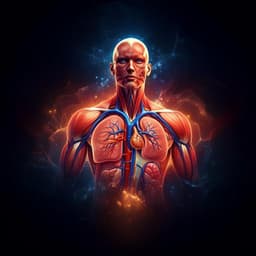
Computer Science
Neural networks and physical systems with emergent collective computational abilities
J. J. Hopfield
Discover how collective properties of simple components can yield powerful computational capabilities in biological systems and computers alike. This groundbreaking research by J. J. Hopfield reveals a model that supports content-addressable memory with remarkable characteristics like generalization and error correction.
~3 min • Beginner • English
Introduction
The paper investigates whether useful computational abilities can arise spontaneously as collective phenomena in large systems of simple, interacting neurons, analogous to emergent behaviors in physical systems (e.g., magnetic domains, fluid vortices). It asks if stability of memories, categorization/generalization, error correction, and time-sequential memory can emerge from interactions among many simple units without complex, predesigned circuitry. The work frames content-addressable memory as dynamics in a high-dimensional state space with locally stable attractors, proposing that a system’s time evolution can retrieve complete stored items from partial cues. The study aims to identify robust collective properties insensitive to modeling details and relevant to neurobiology and to hardware implementations using asynchronous parallel processing.
Literature Review
Prior work on neural computation includes McCulloch and Pitts’ binary neuron model, perceptron models (Rosenblatt; critiques by Minsky & Papert) which emphasized feedforward and synchronous processing and struggled with strong feedback. Linear associative networks (Cooper; Longuet-Higgins; Kohonen; Palm; Anderson) used correlation-based storage but produced mixed outputs under ambiguous inputs and required external nonlinear logic to perform complex computation. Little, Shaw, and Roney studied synchronous on/off neuron networks with spike-timing reverberations. Learning rules rooted in Hebb and Eccles describe synaptic modification via activity correlations. Spin glass theory (Kirkpatrick & Sherrington) provides insight into many local minima in systems with random symmetric couplings. Biological context includes rate coding and feature extraction in sensory pathways, suggesting that higher-level memory/categorization may operate on preprocessed features.
Methodology
Model system: N binary neurons with states V_i ∈ {0,1}. Each neuron i has a threshold U_i (typically 0) and attempts asynchronous stochastic updates with mean rate W_i. Update rule: set V_i to 1 if Σ_j T_ij V_j > U_i, else 0. Connections T_ij represent synaptic strengths (T_ii = 0). Strong recurrent (backward) coupling is allowed; global synchrony is not assumed.
Storage (learning) rule: To store n binary patterns V^s (s=1..n), set T_ij = Σ_s (2V_i^s − 1)(2V_j^s − 1), with T_ii = 0. This Hebbian outer-product rule yields pseudo-orthogonality: for stored pattern s, Σ_j T_ij V_j^s has mean sign aligned with V_i^s (±N/2) with noise from other patterns.
Energy function and attractors: For symmetric T_ij = T_ji, define E = −(1/2) Σ_i Σ_j T_ij V_i V_j. The asynchronous update rule monotonically decreases E, leading to convergence to local minima (Ising-model analogy). For nonsymmetric T, dynamics resembles finite-temperature descent; simulations show persistence of attractors or small wandering regions near minima.
Simulations: Monte Carlo studies for N=30 and N=100 with random T_ij in [−1,1], and with learned T_ij from random memory patterns. Protocols included: (a) starting from stored patterns to test stability/error rates vs number of memories n; (b) starting from random or partially corrupted states to test basin of attraction and categorization; (c) variants with clipped synapses (T_ij → sign(T_ij)), asymmetric connectivity (one-directional i→j or j→i), nonzero uniform thresholds, and bounded/digitized synapses to model forgetting; (d) overload conditions (n≫capacity) to test familiarity detection via processing rate; (e) correlated memory completion by storing partial patterns; (f) adding small nonsymmetric sequential terms to bias transitions among stored patterns for sequence memory.
Analytical estimates: Gaussian noise approximation for crosstalk in Σ_j T_ij V_j^s yields bit error probability P and predicts capacity scaling n ∝ N at fixed error rate. Signal-to-noise analyses quantify effects of clipping (reduction by (2/π)^2) and asymmetry (SNR reduction by 1/√2).
Key Findings
- Content-addressable memory emerges: The network retrieves complete stored patterns from partial cues via convergence to attractors in state space under asynchronous updates.
- Capacity scales linearly: About 0.15 N random binary patterns can be stored and reliably recalled before severe errors occur. For N=100: with n≤5, stored states were almost always stable; at n=15, about half of nominal memories converged to states with <5 bit errors, while others diverged.
- Error probability estimate: For N=100, n=10, predicted bit error P≈0.0091, giving probability of zero errors ≈e^(−0.91)≈0.40; simulations yielded ≈0.6.
- Basins and categorization: With N=30, n=5, ≈85% of random starts converged to assigned memories; ≈10% to spurious minima; ≈5% near assigned memories. Retrieval of the nearest memory exceeded 90% when initial Hamming distance ≤5; probability decreased smoothly with distance (≈0.2 at distance 12).
- Dynamics with random T: For N=30, starting from random states, dynamics settled within ~4/W into stable fixed points most commonly; occasional 2-cycles occurred; also small-region chaotic wandering with entropic measure M≈25 (for N=30).
- Clipped synapses: Using T_ij→sign(T_ij) reduces SNR by (2/π)^2; to maintain the same error probability, the number of storable memories must be reduced by factor 2/π. For N=100, n=9 with clipped T produced error levels similar to n=12 in unclipped case. With μ-variable formulation and clipped T, maximal stored Shannon information for N=100 occurred around n≈13 and was ≈N(N/8) bits.
- Asymmetric connectivity: With only one directed synapse per pair (if T_ij≠0 then T_ji=0), stable minima persisted but with higher error rates; SNR decreased by factor 1/√2; failure is soft as synapses fail.
- Memory interference: Pairs of memories too close in Hamming space can merge or displace minima: at distance 30 both stable, at 20 distinct but displaced, at 10 often fused (N=100).
- Familiarity recognition: Introducing a uniform threshold makes the all-zero state a competing attractor, enabling rejection of unfamiliar inputs. Under heavy overload (N=100, n=500), familiar vs unfamiliar inputs were distinguishable by initial processing rate (faster for unfamiliar), detectable by downstream averaging units.
- Generalization from correlations: Storing many correlated patterns creates an average correlation matrix C; adding a partial pattern X over k<N neurons allows completion of the full pattern guided by Σ_j c_ij X_j.
- Sequence memory: Adding small nonsymmetric sequential terms biases transitions between attractors; sequences up to length ~4 could be induced but not reliably longer.
- Forgetting via bounded synapses: Digitizing and saturating T_ij (e.g., 0, ±1, ±2, ±3) causes natural forgetting of distant memories while retaining recent ones with slightly increased noise (e.g., 0 to ±3 is appropriate for N=100).
Discussion
The findings support the hypothesis that useful computational functions—associative recall, error correction, categorization, familiarity detection, limited sequence encoding—can emerge as collective dynamical properties of large networks of simple, asynchronously updating neurons. The system’s phase-space flow is dominated by basins of attraction around stored patterns, enabling retrieval from partial/noisy cues and statistical resolution of ambiguity. Analytical and simulation results show these properties are robust to substantial variations in modeling details, including synaptic asymmetry, synapse clipping, and device failures, suggesting biological plausibility and practical implementability. The Ising-spin analogy provides a physical interpretation, with a Lyapunov-like energy governing convergence for symmetric couplings and quasi-thermal behavior for nonsymmetric cases. The model aligns with neurobiological rate coding and Hebbian learning principles and implies that complex cognitive capabilities may arise from ensembles of simple circuits through emergent dynamics rather than intricate predesigned logic. Hardware implementations using asynchronous parallel processing could exploit these properties to build fail-soft, large-scale content-addressable memories and specialized processors for pattern completion and categorization.
Conclusion
This work introduces a recurrent, asynchronously updated binary neuron network that, via Hebbian storage, exhibits emergent content-addressable memory with robust retrieval, error correction, categorization, familiarity recognition, limited sequence recall, and soft-failure tolerance. Capacity scales linearly with network size (~0.15 N memories for low error), and the behavior is resilient to modeling changes (e.g., synaptic asymmetry, clipping). The energy-based viewpoint connects the dynamics to physical systems with many local minima, grounding the computational properties in well-understood physics. These insights suggest a bridge from simple neural units to complex computational abilities in biological systems and motivate integrated-circuit realizations leveraging asynchronous parallelism for specialized tasks. Future directions implied include incorporating richer neurobiological details (graded responses, delays, stochasticity), improving sequence memory mechanisms, optimizing thresholds and coding for higher capacity, and developing hardware architectures that implement bounded Hebbian synapses and familiarity detectors.
Limitations
- Simplified neuron model (binary on/off states, step-like input-output) and Hebbian storage rule abstract away many neurobiological details (e.g., graded potentials, spike timing, complex synaptic dynamics).
- Many analyses assume symmetric T_ij for a Lyapunov function; real synapses are often asymmetric, though simulations suggest similar behavior with degraded performance.
- Simulation sizes were modest (N=30 and N=100); larger-scale behavior is inferred but not directly tested here.
- Sequence memory was limited; reliable sequences longer than ~4 states were not achieved.
- Capacity with random patterns saturates at ~0.15 N; overload leads to loss of specific memories unless forgetting mechanisms are employed.
- Effective operation presumes appropriate preprocessing/feature extraction of inputs; the model itself does not perform that stage.
- Familiarity detection under overload requires additional readout mechanisms (e.g., measuring processing rate) beyond the core network.
Related Publications
Explore these studies to deepen your understanding of the subject.







